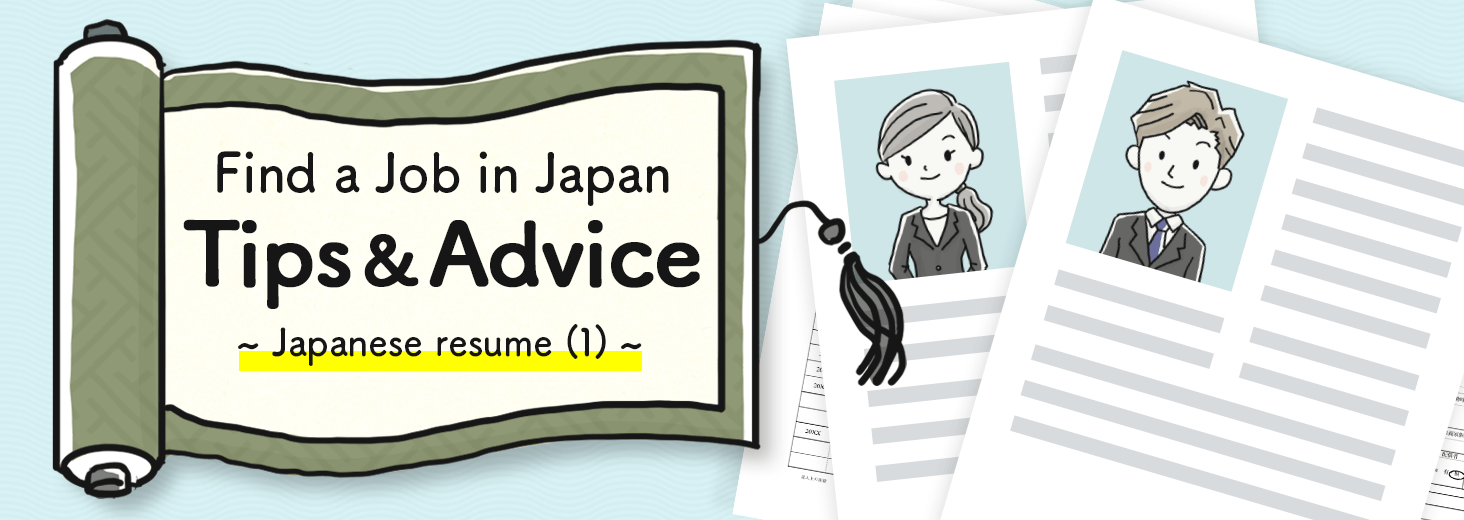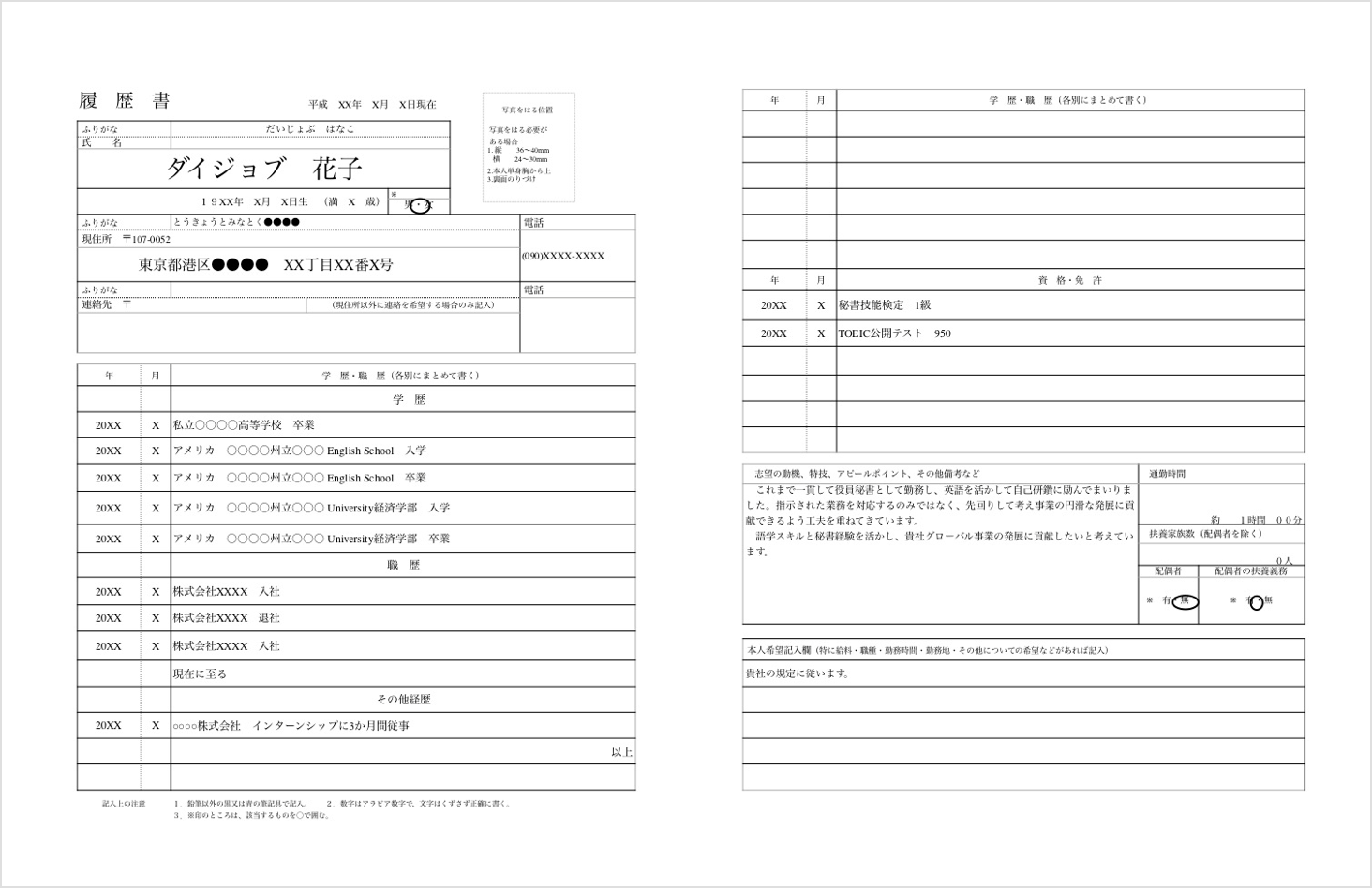Global Career Guide


- Jobs in Japan @ Daijob.com
- Global Career Guide
- Tips & Advice
- Resume
- Japanese resume (1)

1. Rirekisho (Japanese Resume 1)
There are two kinds of resumes commonly used in Japan: 履歴書(rirekisho) and 職務経歴書 (shokumukeirekisho). Rirekisho is a brief overview of your educational and/or work history. It only shows basic yet important details about yourself such as your graduation dates, companies you have worked at and the time you have spent at each company. It is almost seen as a business card for those looking for work.
(1) Writing Points
point 1 Emphasis on readability
You can either use your handwriting or a PC, but make sure your resume is easy to read.
point 2 Unify fonts
The standard fonts used in Japan are Gothic and Mincho. Make sure to only use one font throughout the whole document. Change the size and boldness for the parts you wish to emphasize such as the title or your name.
point 3 The JIS standard
This section explains how to write a well-balanced Japanese resume in the JIS standard, which is the most common in Japan. Some companies may specifically ask for a JIS standard.
It might also be permitted to submit your resume in a free format, but since the JIS standard contains all the information required by the companies, it helps to provide all appropriate information as a formal document.

(2) Basic writing style
① Basic information
- Name, address, age, gender
- Use Hiragana or Katakana
- The photograph should be taken with a white, blue or other plain background, showing the face clearly and taken from the chest up. Wear a nice shirt and a jacket. If you are in Japan, it is recommended to use a photo machine specifically for official photos. You can find them installed in many locations, such as in the train stations or shopping malls.

② Background
- The years are written down in the Japanese calendar style (Showa, Heisei, etc.) and should be listed in chronological order.
- The dates should correspond to the dates written down in the 職務経歴書 (shokumukeirekisyo).
Academic background section (high school, university etc.)
List the name of the school and the major studied. Academic bacground generally starts from senior high school graduation.
If the country in which the school was attended is not included in the name of the school, it is best to write it down before or after the school name. You can use brackets [] to make it more readable.
For short-term study abroad or language school experiences it might be better to create a separate section as to not make the academic background too long.
Work history section
Write the name of the companies you have worked at. For each company listed, write down 2 lines; "株式会社XX入社 (Started work at XX)", "株式会社XX退職 (Left XX)".
In the event of a transfer, enter " XX株式会社へ転籍 (Transferred to XX Kabushiki Kaisha)".
If you work at an organization or government agency, write down the correct Japanese expressions such as "入団 (joining the organization)" or "入庁 (joining the agency)".
Note Departmental transfers and detailed company information
Since all your departments and positions are written in your 職務経歴書 (shokumukeireisho), it is not necessary to write down every time you have been transferred or promoted in your resume. If there are too many positions or departments listed on the resume, it might give an impression of changing jobs too often. ""Employment form,"" ""Department,"" ""Number of employees,"" and ""Business description"" are also not required to be filled out.
Note Employment experience in part-time employment and interns
No particular entry is required, but if you want to make a special appeal, please write it as [Supplement] at the end if you want to fill in the blank. (e.g., part-time workers at shops from October 2000 to October 2000)
Note Reason for resignation
In the event of a dismissal due to bankruptcy, downsizing, withdrawal from business, or personnel reductions, the reason for resignation is "会社都合により退職 (Resignation due to the company's circumstances)". Otherwise, "退職 (Resignation)" or "一身上の都合により退職 (Resignation for personal reasons)".
③ Qualifications and notes
- List the qualification you have acquired along with the date of acquisition.
- Use the official titles for the qualifications (e.g. first class driver's license for ordinary vehicles). Verify the correct information on the certificate or on the internet.
④ Other
- Information on spouse, dependents, etc. This information might be nescessary for the company insurance.
- If you have a blank period in your career history, you can use this space to explain what you did at that time.
⑤ Hobbies, special skills, self-PR, and motivations
- Special skills and hobbies are not mandatory to fill in.
- Self-PR should be written specifically for each company or general as to apply for various companies.
- Your motivion should be tailored to each company you apply for.
※When sending your resume to a recruitment agency, it is recommended to leave the motivation field blank.
⑥ Section to write your conditions, hopes and wishes
- If you do not have any specific conditions, it is recommended to write "貴社の規定に従います (in accordance with your company's regulations)". Writing down your desires is not a problem, but it is important to avoid writing down too many, as to avoid leaving a negative impression.


